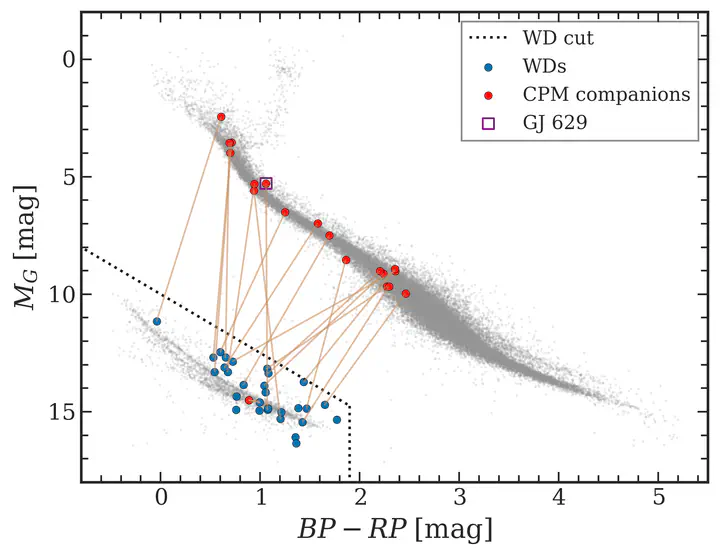 Image credit: Golovin+24
Image credit: Golovin+24
Abstract
Context. A volume-complete sample of white dwarfs is essential for statistical studies of the white dwarf population. The sample of nearby white dwarfs is the only one that allows the faint end of the luminosity function to be probed and thus is the only one that covers the entire range of white dwarf ages. However, due to their intrinsic faintness, even nearby white dwarfs are difficult to identify. Aims. Our work focuses on improving the completeness and purity of the white dwarf census within 50 pc of the Sun. To accomplish this, we used Gaia Data Release 3 (Gaia DR3) to identify and characterise new and previously overlooked white dwarfs in the solar neighbourhood. We also identify objects with spurious astrometric solutions in Gaia DR3 but claimed as high-confidence white dwarfs in the Gaia Catalogue of White Dwarfs (GCWD21) by Gentile Fusillo et al. (2021). Methods. Based on the astrometry and photometry in Gaia DR3, we identified new nearby white dwarfs and validated those that had been missed from recent white dwarf catalogues despite being previously documented. To ensure the reliability of their astrometric solutions, we used a cut on just two parameters from Gaia DR3: the amplitude of the image parameter determination goodness-of-fit and the parallax-over-error ratio. In addition, we imposed photometric signal-to-noise requirements to ensure the reliable identification of white dwarfs when using the colour-magnitude diagram. Results. We have identified nine previously unreported white dwarfs within the local population of 50 pc, and validated 21 previously reported white dwarfs missing from the GCWD21 and other recent volume-limited white dwarf samples. A few of these objects belong to the rare class of ultra-cool white dwarfs. Four white dwarfs in our sample have an effective temperature of Teff ≤ 4000 K within the 1σ interval, and two of them have an absolute magnitude of MG > 16.0 mag. The identified white dwarfs are predominantly located in crowded fields, such as near the Galactic plane or in the foreground of the Large Magellanic Cloud. We also find that 19 of these white dwarfs have common proper motion companions with angular separations ranging from 1.1′′ to 7.1′′ and brightness differences between the components of up to 9.8 magnitudes. One of these systems is a triple system consisting of a white dwarf and two K dwarfs, while another is a double white dwarf system. The identified white dwarfs represent a 1.3% improvement in the completeness of the 50 pc sample, resulting in a new total of 2265 known white dwarfs located within 50 pc of the Sun. We have identified 103 contaminants among the 2338 high-confidence white dwarfs in the 50 pc subsample of the GCWD21 and have found that their astrometric solutions in Gaia DR3 are spurious, improving the purity by 4.4%.